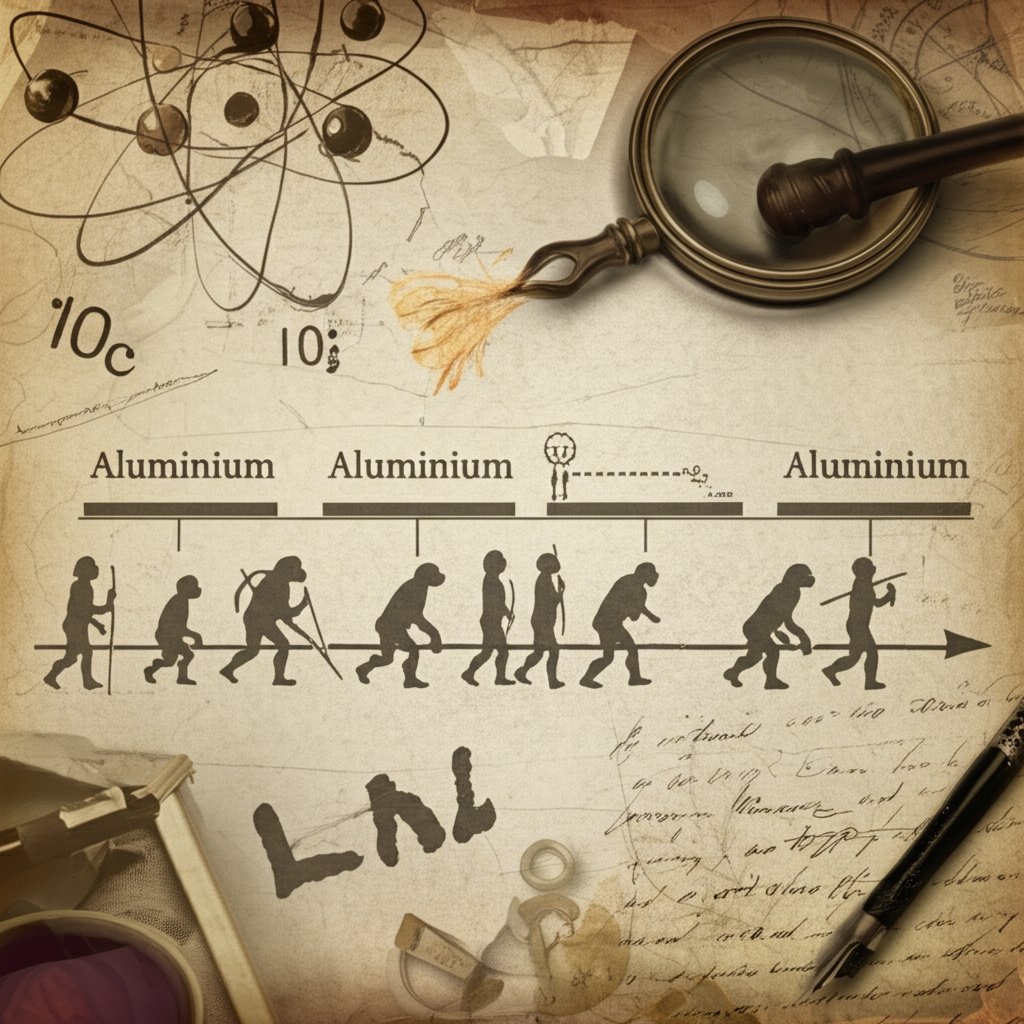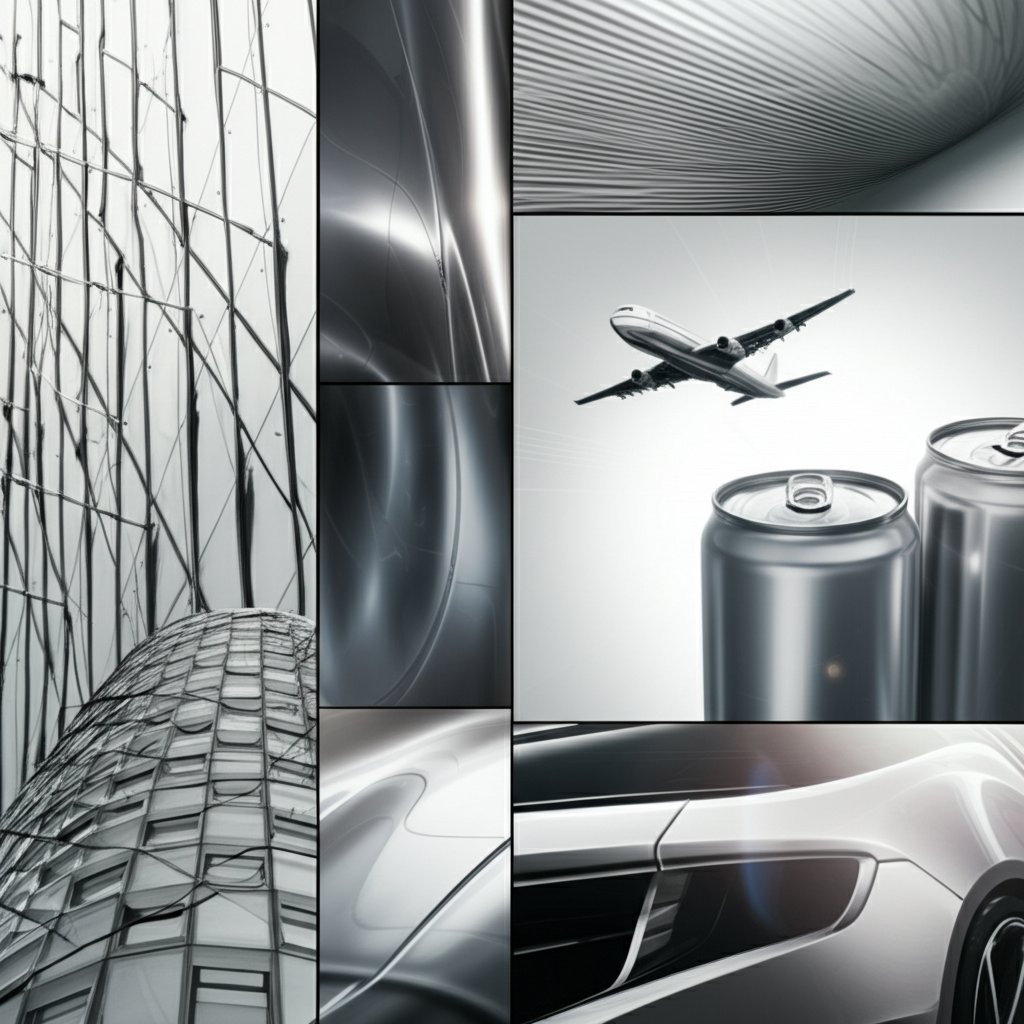-vs-aluminium-(uk).jpg)
Ever stumbled over the spelling aluminum or aluminium? You're not alone! This common linguistic curiosity surrounds element 13, the versatile silvery metal found everywhere from soda cans to spacecraft. So, what's the real aluminum vs aluminium difference? Essentially, it's a regional variation: 'aluminum' is standard in American and Canadian English, while 'aluminium' prevails in British English and most other parts of the world (Dictionary.com, 2023). Despite the different names, both refer to the exact same chemical element. This article will demystify the debate, tracing the historical naming journey, exploring pronunciation differences, confirming the identical science behind both terms, and highlighting key uses – from humble kitchen foil to critical aerospace parts (Wikipedia) and even compounds in antiperspirants. By the end, you'll understand the history, science, and practical implications of both spellings in 2025.

The story behind the aluminum vs aluminium history is a fascinating journey through scientific discovery and linguistic evolution. It begins with the brilliant Cornish chemist, Sir Humphry Davy. Although he didn't isolate the pure metal himself (credit for that often goes to Hans Christian Ørsted in 1825 or Friedrich Wöhler in 1827, depending on the source), Davy identified the existence of a new metallic element within a compound called alum (ThoughtCo). His initial naming attempt in 1808 was 'alumium'. However, just four years later, in his 1812 book Elements of Chemical Philosophy, Davy himself proposed the name 'aluminum' (Gabrian).
So, which came first, aluminum or aluminium? Davy's 'aluminum' spelling technically appeared first in his 1812 publication. However, the debate wasn't settled. Many contemporary chemists and editors, particularly in Britain, felt 'aluminium' sounded more classical and aligned better with the '-ium' suffix used for other elements Davy had isolated, like potassium and sodium. This preference for 'aluminium' quickly gained traction outside the United States.
The divergence solidified over the next century. Here’s a quick look at the key milestones:
This historical back-and-forth, driven by individual preference, linguistic trends, and institutional decisions, ultimately led to the distinct regional spellings we encounter today. But why did these preferences take such strong root in different parts of the world?
So, how did this transatlantic spelling divide happen after Davy's initial proposals? The primary aluminium vs aluminum difference boils down to linguistic evolution and influential figures on both sides of the Atlantic. In the United States, the preference for 'aluminum' owes much to the efforts of Noah Webster, a lexicographer passionate about simplifying English spelling for Americans (Merriam-Webster). Webster famously championed changes like dropping the 'u' from 'colour' and the 'k' from 'musick'. When compiling his influential An American Dictionary of the English Language in 1828, he specifically listed 'aluminum', omitting the '-ium' ending (Gabrian). This dictionary's widespread adoption, coupled with the growing use of the metal in American industry and trade, helped cement 'aluminum' as the standard American vs British spelling aluminum choice in the U.S.
Meanwhile, in the United Kingdom and much of the Commonwealth, the scientific community and general public leaned towards 'aluminium'. This spelling aligned better with the established '-ium' suffix used for many other elements (like sodium, potassium, magnesium), giving it a more 'classical' or scientifically consistent feel (Merriam-Webster). This preference persisted and eventually became the standard in these regions.
Here’s a quick summary of current regional preferences:
While the spelling differs, it's just the tip of the iceberg. These variations also lead to distinct ways of saying the word, which often causes confusion.
Beyond the spelling, the aluminium vs aluminum pronunciation difference is often what catches people's attention. If you've ever wondered how to pronounce aluminum like an American or how to pronounce aluminium like someone from the UK, the key lies in the syllable count and stress pattern. The American spelling, 'aluminum', typically has four syllables with the stress falling on the second one. The British spelling, 'aluminium', adds an extra syllable, making it five syllables long, and shifts the primary stress towards the end.
Let's break it down phonetically using the International Phonetic Alphabet (IPA):
| Spelling | Region | IPA Pronunciation |
|---|---|---|
| Aluminum | US/Canada | /əˈluːmɪnəm/ |
| Aluminium | UK/Others | /ˌæljuːˈmɪniəm/ (Collins Dictionary) |
Notice that extra 'i' in the British 'aluminium'? That's the culprit behind the additional syllable (/miː/ vs. /mɪn/) and the resulting shift in emphasis. This pattern isn't unique; it reflects a common tendency in British English for words ending in '-ium'. So, while the spelling difference stems from historical preferences, the pronunciation variance is a direct phonetic consequence. But does this linguistic divergence mean we're talking about different materials?
-element-13-on-the-periodic-table-emphasizing-its-singular-chemical-identity.jpg)
So, after exploring the history and pronunciation variations, you might wonder: does the spelling difference matter chemically? The simple answer is no. Despite the linguistic divergence, 'aluminum' and 'aluminium' refer to the exact same chemical element. This is the core reason why aluminum vs aluminium is purely a naming convention issue, not a scientific one. On the aluminium vs aluminum periodic table, you'll find only one entry: element 13, universally represented by the symbol Al (PubChem).
As a post-transition metal located in Group 13, Period 3, aluminum possesses distinct and valuable properties. It's renowned for being lightweight yet strong, highly resistant to corrosion (thanks to a rapidly forming protective oxide layer), and an excellent conductor of heat and electricity (Los Alamos National Laboratory). These fundamental element 13 properties—its atomic structure, chemical reactivity, density, melting point, and everything else—remain absolutely identical whether you call it aluminum or aluminium.
Here’s a quick summary of its key scientific facts:
| Property | Value |
|---|---|
| Symbol | Al |
| Atomic Number | 13 |
| Atomic Weight | 26.981538 u (approx.) |
| Common Ore | Bauxite (Wikipedia) |
| Electron Configuration | [Ne] 3s² 3p¹ |
| Common Oxidation State | +3 |
While the pure element itself boasts impressive characteristics, its true potential in many applications is unlocked by mixing it with other elements to enhance specific traits like strength or machinability.
While pure aluminum (or aluminium, the science doesn't change!) has its uses, especially where corrosion resistance or electrical conductivity is paramount, it's often too soft for demanding structural roles. So, how do we get the super-strong yet lightweight aluminum components used in planes or cars? The answer lies in alloys. An aluminum vs aluminium alloy discussion is moot – alloying is key regardless of the name. Engineers create aluminum alloys by mixing pure aluminum with small amounts of other elements like copper, magnesium, silicon, or zinc. Think of it like baking: adding different ingredients changes the final product's texture and strength.
These additions significantly enhance properties like strength, hardness, durability, and workability, tailoring the metal for specific jobs. There are many types of aluminum alloys, broadly categorized into wrought alloys (shaped by rolling, drawing, or extrusion) and cast alloys (poured into molds). Wrought alloys are further divided into series, each with distinct characteristics:
This incredible diversity in alloy properties is precisely why aluminum finds its way into such a staggering array of products and industries.

Thanks to the diverse properties unlocked by alloying, the uses of aluminum (or aluminium!) are incredibly vast and touch nearly every aspect of modern life. Its combination of low weight, impressive strength, corrosion resistance, conductivity, and excellent recyclability makes it a go-to material across countless industries. You likely encounter it daily without a second thought. In the household, it's the stuff of beverage cans and cookware. And that roll of 'tin foil' in your kitchen? It's actually aluminum foil – whether you spell it aluminum foil vs aluminium foil, it’s the same versatile wrap. Appliances often incorporate aluminum components too.
Beyond the home, aluminum is a cornerstone of major industries. Consider aluminum in construction: it forms window and door frames, roofing, and sophisticated curtain wall systems that clad modern skyscrapers. Achieving the complex shapes and energy efficiency required for these systems often relies on specialized aluminum profiles produced by manufacturers with advanced capabilities, like Shengxin Aluminum, whose extrusions are integral to many energy-efficient building projects.
Similarly, aluminum in transportation is crucial for reducing weight and improving fuel efficiency. It's used extensively in cars (body panels, engine blocks, chassis components), trucks, high-speed trains, and especially aircraft, where its strength-to-weight ratio is paramount. Even public transit relies heavily on it; for instance, structural components like robust door beams for numerous subway lines, such as those supplied by Shengxin Aluminum for systems in Beijing, Guangzhou, and Chongqing, demonstrate its importance in demanding, high-traffic environments. Add to this its role in packaging (cans, containers, foil wraps) and electrical transmission (power lines), and its ubiquity becomes clear.
Here’s a quick breakdown of its common applications:
From shielding satellites to wrapping leftovers, aluminum's reach is extraordinary. But its applications extend even further, sometimes into products used directly on our bodies.
Beyond structural materials and packaging, aluminum finds its way into personal care products, most notably antiperspirants. Ever wondered how they work to keep you dry? The key lies in specific aluminum compounds in deodorant products designed to reduce sweat.
The primary antiperspirant mechanism relies on aluminum-based salts. When you apply an antiperspirant, these compounds dissolve in sweat on the skin's surface. They then enter the sweat ducts and form temporary, superficial gel plugs. These plugs physically block the ducts, significantly reducing the amount of sweat that reaches the skin surface. It's important to distinguish this from deodorants, which don't stop sweat but work by killing odor-causing bacteria or masking odors with fragrance.
Several types of aluminum salts are commonly used, including Aluminum Chlorohydrate, Aluminum Zirconium complexes (like Aluminum Zirconium Tetrachlorohydrex GLY), and Aluminum Sesquichlorohydrate. Each has slightly different properties, but all function via the sweat-blocking mechanism. Regulatory bodies like the U.S. Food and Drug Administration (FDA) and equivalent authorities in the European Union closely monitor the safety and concentration of these ingredients in consumer products.
Here’s a quick comparison of common types:
| Compound Type | Primary Action | Typical Use | Notes |
|---|---|---|---|
| Aluminum Chlorohydrate | Sweat blocking | Antiperspirant | Common, generally well-tolerated |
| Aluminum Zirconium complexes | Sweat blocking | Antiperspirant | Often considered more effective (comparing aluminum chlorohydrate vs aluminum zirconium effectiveness is common) |
| Aluminum Sesquichlorohydrate | Sweat blocking | Antiperspirant | Another common variant |
| Potassium Alum (Natural Salt) | Mild astringent | Natural Deodorants | Less potent sweat blocking, sometimes found in 'natural' options |
Understanding how these compounds work helps clarify product labels and choices, but what about broader considerations like sustainability and health perceptions?

Beyond understanding how aluminum compounds work in products like antiperspirants, making informed choices involves considering sustainability, health perceptions, and deciphering product labels. When you encounter aluminum, whether in packaging or personal care, a few key points can help guide your decisions.
One of aluminum's most significant advantages is its recyclability. Wondering is aluminum sustainable? Its ability to be recycled repeatedly without losing quality is a major plus. The aluminum recycling benefits are substantial; recycling aluminum requires only about 5% of the energy needed to produce primary aluminum from bauxite ore. This dramatically reduces its environmental footprint, making recycling aluminum cans, foil, and packaging a highly effective way to conserve resources and energy.
Navigating personal care aisles requires careful reading deodorant labels. It's crucial to understand the difference when considering aluminum vs aluminium free deodorant options. 'Antiperspirants' contain aluminum compounds specifically designed to block sweat ducts and reduce wetness. 'Deodorants', on the other hand, primarily target odor-causing bacteria or mask scent; they may or may not contain aluminum compounds, and they don't stop sweat. An 'aluminum-free' label explicitly means the product lacks those sweat-blocking aluminum salts. Also, be aware that 'natural' deodorants might still contain aluminum compounds like potassium alum, which is a naturally occurring aluminum salt.
You might have encountered discussions online or elsewhere linking aluminum exposure (from antiperspirants, diet, or cookware) to various health concerns. However, major health organizations and regulatory bodies worldwide, after extensive reviews, have generally found insufficient scientific evidence to support a causal link between aluminum exposure from these common sources and conditions like breast cancer or Alzheimer's disease. It's always wise to rely on information from reputable health authorities and scientific consensus rather than anecdotal claims.
Here are a few tips for conscious consumption:
Understanding these aspects allows for more confident choices regarding the aluminum products we use daily. Now, let's bring together the threads of history, science, and application to conclude our exploration of aluminum versus aluminium.
So, what's the final aluminum vs aluminium conclusion? As we've explored, the difference boils down entirely to linguistic history and regional spelling preferences, primarily between North America and the UK/Commonwealth (Eco Alum). Chemically and physically, 'aluminum' and 'aluminium' are identical – referring to the same versatile, lightweight, and corrosion-resistant element (Al). Whether you encounter it in kitchen foil, skyscraper facades, or aircraft components, its fundamental properties remain unchanged.
While it's helpful to use the term most common in your region or industry, recognizing both spellings refer to the same vital material is key. The ongoing importance of aluminum cannot be overstated, especially considering the future of aluminum applications. Its unique combination of strength, low weight, and recyclability makes it indispensable for sustainable progress in areas like renewable energy infrastructure (solar panel frames), efficient transportation (lightweight EVs), and advanced construction (IEA). For projects demanding these high-performance solutions, from intricate architectural designs to robust transportation components, partnering with manufacturers equipped with advanced capabilities like large-scale precision extrusion ensures optimal results and material quality needed for tomorrow's innovations.
The two spellings, 'aluminum' (US/Canada) and 'aluminium' (UK/rest of world), stem from historical naming preferences. Sir Humphry Davy first proposed 'aluminum' in 1812, but British contemporaries favored 'aluminium' to align with other elements ending in '-ium'. The American Chemical Society adopted 'aluminum' in 1925, while IUPAC accepted 'aluminium' internationally in 1990, acknowledging 'aluminum' as a variant.
British English speakers generally use 'aluminium' because early 19th-century British scientists and editors preferred this spelling. They felt it sounded more classical and consistent with other element names discovered around that time, such as sodium and potassium, which end in '-ium', even though Davy's 1812 suggestion was 'aluminum'. This preference became standard in the UK and most Commonwealth nations.
Yes, absolutely. Despite the different spellings and pronunciations, 'aluminum' and 'aluminium' refer to the exact same chemical element (Al) with atomic number 13. Its properties – lightweight, corrosion-resistant, conductive – and its position on the periodic table are identical regardless of which name is used.
The primary difference lies in the number of syllables and stress pattern. 'Aluminum' (US/Canada) typically has four syllables (/əˈluːmɪnəm/) with stress on the second syllable. 'Aluminium' (UK/Others) has five syllables (/ˌæljuːˈmɪniəm/) due to the extra 'i', with the primary stress shifted towards the end.
This versatile metal is used everywhere due to its favorable properties. Common applications include household items (foil, cans, cookware), construction (window frames, curtain walls), transportation (cars, planes, trains), packaging (cans, containers), and electrical transmission lines. Specialized profiles, like those from manufacturers such as Shengxin Aluminum, are used in demanding applications like EV chassis and energy-efficient building systems.
 خدمة الإنترنت
خدمة الإنترنت 0086 136 3563 2360
0086 136 3563 2360 sales@sxalu.com
sales@sxalu.com +86 136 3563 2360
+86 136 3563 2360